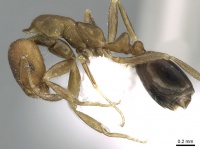Monomorium moathi
| Monomorium moathi | |
|---|---|

| |
| Scientific classification | |
| Kingdom: | Animalia |
| Phylum: | Arthropoda |
| Class: | Insecta |
| Order: | Hymenoptera |
| Family: | Formicidae |
| Subfamily: | Myrmicinae |
| Tribe: | Solenopsidini |
| Genus: | Monomorium |
| Species group: | salomonis |
| Species: | M. moathi |
| Binomial name | |
| Monomorium moathi Sharaf & Collingwood, 2010 | |
Nothing is known about the biology of Monomorium moathi.
Identification
Sharaf & Collingwood (2010) - Distinguished by the combination of the following characters: Colour brown, gaster blackish with characteristic bluish or violet reflection, general appearance dull. Eyes oval with eleven ommatidia in the longest row. Metanotal groove shallow but distinct. Head, mesosoma and waist distinctly shagreenate granulate. Gaster finely shagreenate. Body lacking pilosity except few short hairs in front of eyes, one or two long hairs on head ventrum and many long hairs on gastral ventrum.
This new species is a member of the Monomorium salomonis-group as defined by Bolton (1987).
Monomorium moathi, is a species morphologically similar to Monomorium areniphilum. Both have the following characters: median portion of mesonotum flat to shallowly convex, mesosoma without hairs, propodeal furrow present and distinctly margined, highest point of propodeal dorsum behind metanotal groove on a much lower level than the highest point of the promesonotum. Differences: Monomorium moathi is consistently smaller, TL 2.41-2.48 versus TL 3.1-4.30 in areniphilum. Monomorium moathi has a lower head length, HL 0.61-0.65 versus HL 0.86-1.04; has a lower scape length, SL 0.46-0.52 versus SL 0.68-0.88, has smaller eyes EL 0.23-0.24X HW versus 0.30-0.35X HW in areniphilum. Dorsum of head in M. moathi without hairs except few short ones in front of eyes, whereas in areniphilum head dorsum with 1-2 pairs of hairs which straddles the midline. In addition, petiole and postpetiole in M. moathi are bare, while in M. areniphilum petiole has one pair and postpetiole with 2-3 pairs of backwards directed hairs. Moreover, head dorsum in M. moathi is finely shagreenate or shagreenate granulate, whereas in M. areniphilum head dorsum with fine dense reticulate to reticulate-shagreenate sculpture. Additionally, metanotal groove in M. moathi distinct but not deep, while in M. areniphilum metanotal groove conspicuously impressed and deep.
Distribution
Distribution based on Regional Taxon Lists
Afrotropical Region: Yemen (type locality).
Distribution based on AntMaps
Distribution based on AntWeb specimens
Check data from AntWeb
Countries Occupied
| Number of countries occupied by this species based on AntWiki Regional Taxon Lists. In general, fewer countries occupied indicates a narrower range, while more countries indicates a more widespread species. |

|
Estimated Abundance
| Relative abundance based on number of AntMaps records per species (this species within the purple bar). Fewer records (to the left) indicates a less abundant/encountered species while more records (to the right) indicates more abundant/encountered species. |

|
Biology
Castes
Known only from the worker caste.
Nomenclature
The following information is derived from Barry Bolton's Online Catalogue of the Ants of the World.
- moathi. Monomorium moathi Sharaf & Collingwood, in Aldawood, et al. 2010: 38, figs. 1, 2 (w.) YEMEN.
- Type-material: holotype worker.
- Type-locality: Yemen: (no further data), 1999 (C.A. Collingwood).
- Type-depository: KSMA.
- Status as species: Borowiec, L. 2014: 122.
- Distribution: Yemen.
Unless otherwise noted the text for the remainder of this section is reported from the publication that includes the original description.
Description
Worker
Holotype: TL: 2.41; HL: 0.65; HW: 0.52; SL: 0.52; ML: 0.75; PRW: 0.35; EL: 0.12; PL: 0.18; PW: 0.19; PPL: 0.11; PPW: 0.19 Indices: CI: 80; SI: 100.
Paratypes: 3 workers; TL: 2.48; HL: 0.61-0.65; HW: 0.48-0.52; SL: 0.46-0.52; ML: 0.63-0.78; PRW: 0.28-0.35; EL: 0.11-0.12; PL: 0.19-0.22; PW: 0.17-0.26; PPL: 0.12-0.14; PPW: 0.19 Indices: CI: 80-83; SI: 96-100 (one paratype is sound and the other two with broken gasters, same data as holotype).
Body brown, gaster blackish with characteristic bluish or violet reflection, general appearance dull. Head distinctly longer than broad. Occipital margin shallowly concave with rounded corners. Head sides feebly convex in full-face view. Eyes oval, relatively large (EL 0.23-0.24X HW) with eleven ommatidia in the longest row. Median portion of anterior clypeal margin concave. Mandibles longitudinally striate and shining. Antennal scapes, when laid straight back from their insertions, just reach occipital margin. Antennae with dense pubescence. Promesonotum straight in profile. Metanotal groove distinct in profile. The propodeal dorsum feebly depressed medially without sharp lateral margins. Petiole node high and pointed in profile. Postpetiole node rounded and much lower than petiole node. Head dorsum, mesosoma and waist with distinct shagreenate granular sculpture. Dorsal head, mesosoma, waist and gaster lacking standing hairs of any descriptions. Few short hairs in front of eyes, one or two long hairs on head ventrum, gastral ventrum with long hairs. Gaster very finely and densely shagreenate.
Type Material
Holotype. worker, Yemen, unknown locality, 1999 (C. A. Collingwood), King Saud Museum of Arthropods (King Saud Museum of Arthropods).
Etymology
This species is named after the friend of Prophet Mohammed, Moath Ebn Jabal who was sent to Yemen to distribute Islam.
References
- [[Media:Aldawood Sharaf Collingwood 2010.pdf|Aldawood, A.S., Sharaf, M.R. and C.A. Collingwood. 2010. Monomorium moathi sp. n., a new ant species from Yemen (Hymenoptera: Formicidae) related to the salomonis-group. Egyptian Academic Journal of Biological Sciences A Entomology. 3(2)*Borowiec, L. 2014. Catalogue of ants of Europe, the Mediterranean Basin and adjacent regions (Hymenoptera: Formicidae). Genus (Wroclaw) 25(1-2): 1-340.
- Sharaf, M.R., Mohamed, A.A., Boudinot, B.E., Wetterer, J.K., Hita Garcia, F., Al Dhafer, H.M., Aldawood, A.S. 2021. Monomorium (Hymenoptera: Formicidae) of the Arabian Peninsula with description of two new species, M. heggyi sp. n. and M. khalidi sp. n. PeerJ 9, e10726. (doi:10.7717/peerj.10726).
- 37-42.]]

